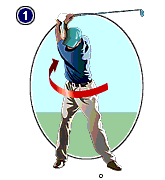 | ||
 | ||
 | Home | |
 | Ball | |
 | Club | |
 | Swing | |
 | Club-ball physics | |
 | Ball in flight | |
 | Product Spotlight | |
 | Bibliography | |
 | ||||
| [Physics of the Golf Swing] | ||||
 | ||||
 |
 | |||
|
A proper golf swing obviously has an enormous impact on your game of golf. The golf swing has physics written all over it and is a great example of angular motion. The twisting swing produces torque on the club. This torque force changes the angular velocity of the club, causing rotation. Most club heads weigh about the same, so the key to being able to hit the long ball lies in the club head velocity. The faster your club head is going at the bottom of your swing, the greater the amount of kinetic energy that will be transferred from club head to the ball because the kinetic energy is proportional to the mass of the club head and the square of its velocity.
Professional golfers can generally achieve a club head speed of 100 M.P.H. at the bottom of their swing. Tiger Woods, however, can reach up to 125 M.P.H. According to research done by Raymond Penner, a physicist at Malaspina University-College in British Columbia, there is an optimum lie angle (angle between club shaft and club face) of a golf driver depending on the club head speed. For example, he found that a 7.5 degree lie angle will allow Tiger Woods to maximize his drive while golfers who swing slower would probably use a club with a lie angle closer to 20 degrees. A typical way people try to hit a ball harder is to snap their wrists at the bottom of their swing. Although this may feel like you are getting more power out of your swing, this action actually slows the club head down, according to Theodore Jorensen, a golf expert who has published works on the physics of golf. So how can Tiger Woods, a man who is 6’1” and only 158 pounds, manage to have one of the longest drives amongst all professional golfers? The answer is that he is able to focus and conserve the energy in his swing through very careful and proper technique. Here are 4 key elements of Tiger Woods’ swing: Here is a Quicktime movie of an “ideal” golf swing. According to this clip of an ideal swing, the club head should have a speed of about 100 M.P.H. “The ball leaves the tee at about 140 mph with a backspin of fifty to sixty rotations per second. (http://kingfish.coastal.edu/physics/projects/2000_Spring/golf/)” This will maximize the distance of your drive.
| ||||
 | ||||

